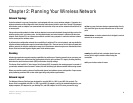
4
Chapter 2: Planning Your Wireless Network
Network Topology
Wireless-N Access Point with Power Over Ethernet
Chapter 2: Planning Your Wireless Network
Network Topology
A wireless network is a group of computers, each equipped with one or more wireless adapters. Computers in a
wireless network must be configured to share the same radio channel to talk to each other. Several PCs equipped
with wireless cards or adapters can communicate with each other to form an ad-hoc network without the use of
an access point.
Linksys also provides products to allow wireless adaptors to access wired network through a bridge such as the
wireless access point, or wireless router. An integrated wireless and wired network is called an infrastructure
network. Each wireless PC in an infrastructure network can talk to any computer in a wired or wireless network
via the access point or wireless router.
An infrastructure configuration extends the accessibility of a wireless PC to a wired network, and may double the
effective wireless transmission range for two wireless adapter PCs. Since an Access Point is able to forward data
within a network, the effective transmission range in an infrastructure network may be more than doubled since
Access Point can transmit signal at higher power to the wireless space.
Roaming
Infrastructure mode also supports roaming capabilities for mobile users. Roaming means that you can move your
wireless PC within your network and the access points will pick up the wireless PC's signal, providing that they
both share the same wireless network (SSID) and wireless security settings.
This Access Point has 802.11F Inter-Access Point Protocol (IAPP) to complete the roaming process in seconds. If
your wireless networks share the same IP subnet, this will not disrupt your data connection while moving around.
Before you consider roaming, choose a feasible radio channel and optimum access point position. Proper access
point positioning combined with a clear radio signal will greatly enhance performance.
Network Layout
The Wireless-N Access Point has been designed for use with 802.11n, 802.11g and 802.11b products. The
Access Point is compatible with 802.11n, 802.11g and 802.11b adapters, such as the notebook adapters for your
laptop computers, PCI adapters for your desktop PCs, and USB adapters for all PCs when you want to enjoy
infrastructure: a wireless network that is bridged to a wired
network via an access point.
ad-hoc: a group of wireless devices communicating directly
with each other (peer-to-peer) without the use of an access
point.
roaming: the ability to take a wireless device from one
access point's range to another without losing the
connection.
ssid: your wireless network's name


















